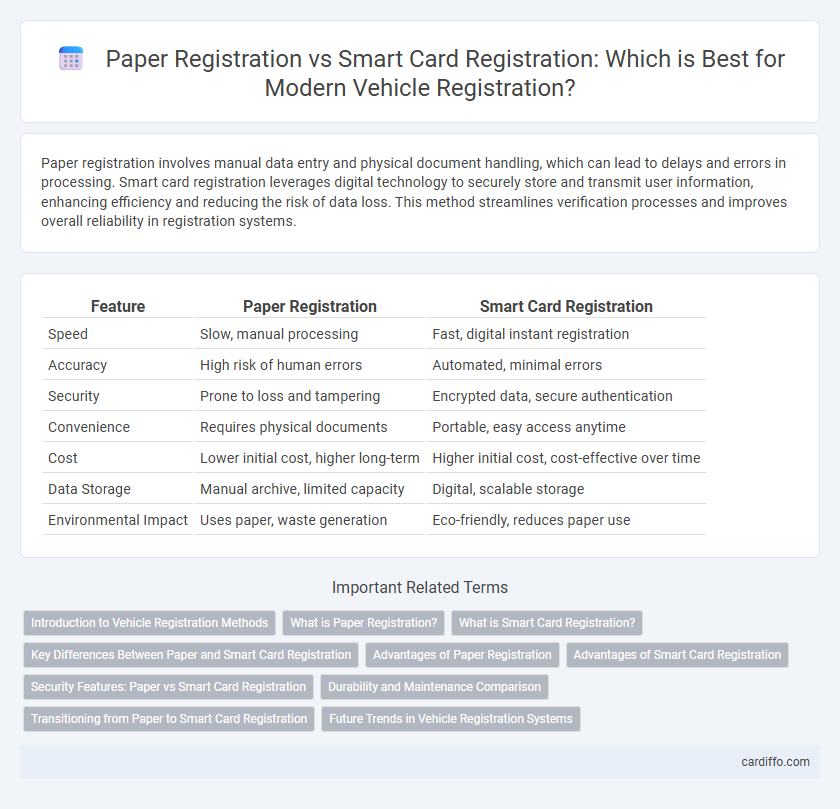Paper registration involves manual data entry and physical document handling, which can lead to delays and errors in processing. Smart card registration leverages digital technology to securely store and transmit user information, enhancing efficiency and reducing the risk of data loss. This method streamlines verification processes and improves overall reliability in registration systems.
Table of Comparison
| Feature | Paper Registration | Smart Card Registration |
|---|---|---|
| Speed | Slow, manual processing | Fast, digital instant registration |
| Accuracy | High risk of human errors | Automated, minimal errors |
| Security | Prone to loss and tampering | Encrypted data, secure authentication |
| Convenience | Requires physical documents | Portable, easy access anytime |
| Cost | Lower initial cost, higher long-term | Higher initial cost, cost-effective over time |
| Data Storage | Manual archive, limited capacity | Digital, scalable storage |
| Environmental Impact | Uses paper, waste generation | Eco-friendly, reduces paper use |
Introduction to Vehicle Registration Methods
Vehicle registration methods vary significantly between traditional paper registration and modern smart card registration systems. Paper registration involves issuing physical documents that serve as proof of ownership and vehicle details, whereas smart card registration uses electronic cards embedded with digital data for enhanced security and easy verification. Smart card registration offers advantages such as fraud prevention, quicker processing times, and seamless integration with online databases for real-time updates.
What is Paper Registration?
Paper registration involves manually filling out physical forms to record personal information, typically used for event sign-ups, vaccinations, or official documentation. This traditional method requires handling, storing, and processing paper documents, which can lead to slower data retrieval and increased risk of errors or loss. While straightforward, paper registration lacks the efficiency and security features of digital alternatives like smart card registration.
What is Smart Card Registration?
Smart Card Registration involves using a physical card embedded with a microchip to securely store and transmit user information during the enrollment process. This method enhances data accuracy, reduces fraud risk, and enables faster identity verification compared to traditional paper registration. Governments and organizations increasingly adopt Smart Card Registration to streamline access control and improve record management efficiency.
Key Differences Between Paper and Smart Card Registration
Paper registration requires manual entry of personal information and physical document submission, leading to longer processing times and higher risk of errors. Smart card registration uses embedded microchips to store encrypted data, enabling faster verification and automated authentication processes. Security enhancements in smart card registration significantly reduce fraud compared to the traditional paper registration method.
Advantages of Paper Registration
Paper registration offers a reliable and accessible method for documenting participant information without the need for digital devices or internet connectivity. It ensures data security by minimizing risks associated with cyber threats and system failures that can affect smart card registration. Furthermore, paper registration simplifies the verification process through physical records, enabling easy cross-checking and manual corrections.
Advantages of Smart Card Registration
Smart Card Registration offers enhanced security by using encrypted digital credentials, reducing identity fraud compared to traditional paper registration. It streamlines the verification process, enabling faster and more accurate data handling through electronic systems. Furthermore, Smart Card Registration supports easy updates and remote access, improving user convenience and administrative efficiency.
Security Features: Paper vs Smart Card Registration
Paper registration relies on physical documents that are susceptible to forgery, loss, and damage, posing significant security risks. Smart card registration incorporates embedded microchips and encryption technologies, enhancing data protection and reducing identity theft. Advanced biometric verification integrated into smart cards further strengthens authentication compared to traditional paper methods.
Durability and Maintenance Comparison
Paper registration forms are susceptible to physical damage such as tearing, water exposure, and fading, leading to frequent replacement and increased maintenance costs. In contrast, smart card registration offers superior durability with resistant materials that withstand wear and environmental factors, resulting in lower long-term maintenance. The enhanced lifespan of smart cards reduces administrative burden and ensures more reliable data retention compared to fragile paper records.
Transitioning from Paper to Smart Card Registration
Transitioning from paper registration to smart card registration enhances security by reducing the risk of forgery and data loss inherent in paper-based systems. Smart card registration streamlines data management through digital encryption and real-time verification, improving accuracy and efficiency. Government agencies and organizations increasingly adopt smart card technology to ensure seamless identification and authentication processes.
Future Trends in Vehicle Registration Systems
Future trends in vehicle registration systems emphasize a shift towards smart card registration due to enhanced security, faster processing times, and integration with digital databases. Paper registration methods are gradually becoming obsolete as governments implement smart card technology that supports real-time updates and remote access. This evolution aims to reduce fraud, streamline administrative workflows, and improve user convenience in vehicle management.
Paper Registration vs Smart Card Registration Infographic

 cardiffo.com
cardiffo.com